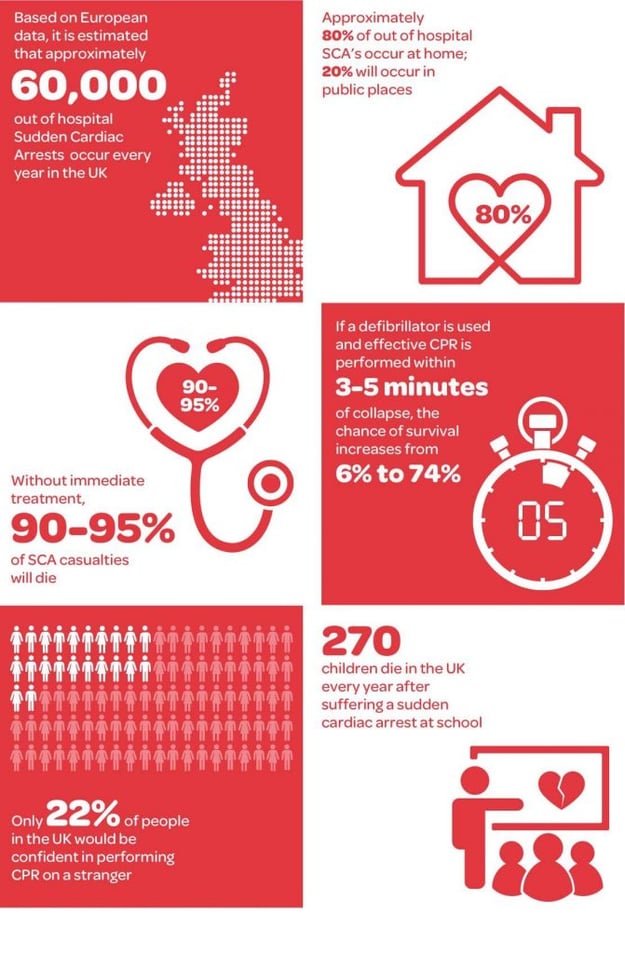Every year, around 60,000 individuals suffer a Sudden Cardiac Arrest (SCA) outside hospital in the UK. Medical emergencies such as SCA can be life-threatening, so it’s sensible to consider what you would do if one of your employees or visitors suffered one.
Given the importance of health & safety in facilities management within the UK, having the right provisions in place to combat SCA can be the difference between life and death.
Chapter 1: Industry Overview – the current state of health & safety in facilities management
The world of facilities management is dominated by legislation. Legal and regulatory compliance is one of the cornerstones of successful facilities management, and nowhere is this more apparent than in the health and safety side of the job.
The Health and Safety Regulations 1981 outline how employers must create a safe working environment for their staff. The result is the development of industry-specific health and safety plans, ensuring employees are able to benefit from enhanced health and safety measures.
Within the facilities management sector, health and safety managers must also adhere to regulations such as manual handling directives, the use of personal protective equipment (PPE) or the provision and the use of work equipment regulations, to name but a few.
Yet despite the regulatory nature of the industry and the fact that the Health and Safety Executive (HSE) only recommend that certain businesses have defibrillators, cardiac health is still often overlooked. Every office, building site and factory in the UK requires a fire extinguisher and fire blanket, by law. Currently, having a defibrillator is not a legal requirement.
Here, we outline why it’s imperative that all businesses have a defibrillator and how you can take steps to safeguard your key stakeholders.
Chapter 2: Sudden Cardiac Arrest (SCA): the facts
In many ways, the facilities management sector can be classed as a high-risk sector – given the number of people passing through a building, the variety in age and nature of the location (business parks/centres).
Yet regardless of industry, SCA does not discriminate. Factors including the victim's current health condition, age and gender do not feature when determining the cause.
The cause of SCA is ventricular fibrillation of the heart. Ventricular fibrillation happens when an electrical malfunction occurs, causing the heart to stop pumping blood and ‘fibrillate’ instead. Sudden Cardiac Arrest causes the victim to lose consciousness and stop breathing.
A heart attack is different and occurs when an artery that supplies the heart with blood and oxygen becomes blocked. Symptoms include chest pain, shortness of breath and feeling weak or lightheaded. Without immediate treatment, a heart attack can lead to cardiac arrest.
Key facts:
- Based on European data, it is estimated that there is approximately 60,000 out of hospital Sudden Cardiac Arrests that occur every year in the UK
- Approximately 80% of out of hospital SCA’s occur at home; 20% will occur in public places
- Without immediate treatment, 90-95% of SCA casualties will die
- If a defibrillator is used and effective CPR is performed within 3-5 minutes of collapse, the chance of survival increases from 6% to 74%
- Only 22% of people in the UK would be confident in performing CPR on a stranger
- 270 children die in the UK every year after suffering a sudden cardiac arrest at school
Response times: the facts
- The emergency services average response time to a cardiac event related incident in an urban area is 11 minutes
- For every minute that goes by where a casualty does not receive treatment, the chance of survival decreases by 10%
- The likelihood of causing harm to the casualty by performing CPR or using an AED is very small
- CPR will maintain an oxygen supply to the patient's brain and other vital organs protecting them until the heart can be restarted by a defibrillator
- The main reason so few people survive Sudden Cardiac Arrest is due to defibrillation not being provided quickly enough after they have collapsed
Chapter 3: Health & safety in facilities management: defibrillators in the workplace and how employers can protect employees
Employers have a duty of care to look after the wellbeing of their staff. Whether you’ve got a large and varied workforce, work with high-voltage equipment, or simply want to protect your staff, installing a defibrillator dramatically improves the survival chances of anyone who suffers a SCA at work.
While there is no law in regards to having a defibrillator on site, you should consider AED requirements in your first aid needs assessment as stated by the UK Resuscitation Council:
“All businesses and organisations will undertake a first aid needs assessment to determine the level of first aid provision within their workplace as a part of their responsibilities to protect the safety of their workforce and visitors. As an organisation or company it is a legal requirement to take precautions to reduce foreseeable risks, to document this and be able to present it to the HSE if requested. As part of this assessment it is quite appropriate to consider the risk of a cardiac arrest occurring in the workplace and investing in automated external defibrillators (AED).”
A key reason why so few people survive SCA is that a defibrillator is not used early enough. The only way to successfully treat a casualty is with effective CPR and defibrillation. The average response time for an ambulance is 11 minutes in urban areas and this is often too late. Therefore, swift treatment from a defibrillator is essential to help save a patient’s life.
As it’s a portable device, an AED can quickly be transported to a casualty to administer electric shocks and restore the normal rhythm of the heart. Defibrillators are designed to be easy to use and guide the user through the whole process with audio and visual cues depending on the model. Anyone can use an Automated External Defibrillator to save the life of someone in cardiac arrest.
A defibrillator has pads that are placed on the casualty’s chest. These pads assess the heart to identify whether or not the individual is suffering cardiac arrest and in need of a shock from the device. A shock will be delivered automatically when required if the device is fully automatic, or by pressing a flashing button as instructed if the device is semi automatic. As well as potentially saving lives, installing a defibrillator sends a clear message to your staff that you are proactively investing in health and safety.
Sudden Cardiac Arrest comes without warning, your staff will be much better protected if your workplace is ready and prepared to deal with it.
Such is the innovative nature of defibrillators, AEDs guide users through the rescue process – the intention being that anyone can pick one up and use it without training. However, ensuring defibrillator training is part of your first aid mandate is highly advisable as stated by the HSE:
Employers should provide information and written instructions, for example from the manufacturer of the AED, on how to use it. Fuller training, however, is likely to make the user more confident and is now an integral part of the syllabus for FAW and EFAW courses.
Chapter 4: Using the right type of AED for facilities management companies
Your working environment will determine the best defibrillator for your needs. Given that facilities management companies are likely to be dealing with residential and commercial buildings, picking the right type of AED ensures the best chance of survival.
Different workplace environments present different risks. After rigorous testing, all defibrillators are assigned an IP rating that determines what the device can withstand. Examples include:
- IP21: protected from touch and condensation
- IP44: protected from tools, small wires and water splashing
- IP56: protected against limited dust ingress and strong jets of water
For shock delivery, investors can either choose from a semi-automatic or a fully automatic. A fully automatic defibrillator will deliver the shock of its own accord whereas a semi-automatic requires responders to press a button to deliver the shock.
Given the varying nature of facilities management, you are likely to require access to a portable and robust unit with an IP rating of higher than 54. Furthermore, some environments are often dusty and sometimes exposed to the elements which means that a more durable unit is required.
Here we have listed three defibrillators which are perfectly suited to a facilities management environment.
Chapter 5: Why defibshop
Since 2005, defibshop has set the standard for the distribution of defibrillators as the country’s largest independent supplier of AEDs in the UK; stocking a wide range of defibrillators available on the market for workplaces and public locations nationwide.
Our vision is to equip everyone to be able to save a life. To date, defibshop has helped to place over 24,000 defibrillators since we began, and we will continue until our vision is achieved.
We have taken ownership of a wide client base including notable companies such as Shell, ITV, Rolls-Royce, JD Sports and BMW. We help all companies large or small as well as leisure centres or public hotspots and even households to become heart safe by getting them equipped with a defibrillator.
We are committed to getting as many defibrillators out into public places, as for us – that means we’re saving as many lives as possible.
If you’re looking to install a defibrillator in your workplace, then speak to our friendly and knowledgeable team. defibshop are committed to equipping everyone with the skills and knowledge to save a life. Speak to one of our Product Specialists on 0161 776 7422 or fill out our Contact Form.







